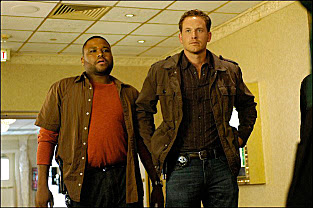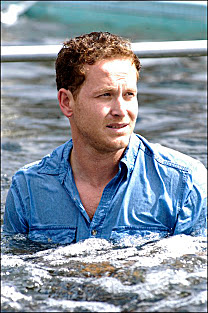The K-Ville pilot, written by creator/executive producer Jonathan Lisco, almost looks like a front-loader. But it isn’t. In fact the structure of this pilot is a thing of beauty which can only truly be appreciated in its deconstruction.
The basics: K-Ville is a cop series set in post Katrina New Orleans. The first episode is a premise pilot. It has four acts and a tag.
The series focuses first and foremost on Marlin Boulet, a cop who survived Katrina. His new partner Trevor Cobb is the second main player. Surrounding them are a cast of characters who populate the police force: other cops and the tenacious but good-humoured Captain.

Like many pilots we’ve seen, one major story thread sets up the series premise (A) and another involves the case of the week (B). A third storyline follows Marlin’s relationship with his ex-partner Charlie (C).
Act One is made up of seven sequences.
The first shows us a man nearly drowning as the water reaches almost ceiling height with barely room for him to keep his head above water. This, we will realize later is Trevor Cobb.
In the next sequence we meet police officer Marlin Boulet. Katrina is flooding New Orleans. Pandemonium, water, citizens in dire need and at the height of the craziness, Marlin’s partner Charlie bails, taking the squad car.
These two sequences aren’t just here by happenstance. They are moments that have changed both men. Katrina reshaped the lives of both these guys and made them who they are when we meet them two years later in sequences two and three.
Is this front loading? Did Lisco just spoon feed us the premise? No. Over the course of the episode we come to understand the toll Katrina took on Marlin. Plus this first scene ties nicely into the Charlie C-story. And finally, Lisco is saving a reveal for the final scene of the episode, which sheds new light that first Cobb scene.
So the premise bookends the episode, with scenes at the top and bottom of the show that inform our appreciation of the series premise. And lots of scenes in between that slowly reveal how Katrina reshaped Marlin.
The third sequence in act one shows us Marlin two years after Katrina in a New Orleans that is slowly coming back. Devastation is everywhere including in this man, who is now making himself a sandwich and dancing to music that is playing. But he leaps out the kitchen window to tackle a kid trying to dig up his cypress tree. He threatens the kid and then asks about his parents. The sequence is all about what Marlin has become.
And sequence four shows us what Cobb has become two years later as he stands next to a car pulling a trailer and surveys New Orleans.
The fifth sequence brings the two men together. They meet and are partnered up by their captain with the rest of the squad looking on. The sequence also introduces the mystery surrounding Cobb. Why on earth would a northern become a New Orleans cop with all the problems Katrina has brought? He’d have to be “half a nut job”. Cobb cheerfully accepts the title.
The sixth and penultimate sequence of the act shows us the two lead chara cters at work, policing a fundraiser. Marlin is drinking, but Cobb doesn’t drink on duty. As committed as Boulet is to New Orleans and his job as a cop, he is not too worried about the rules. We’re beginning to get a picture of him as an anti-hero, devoted to rebuilding his city, but lax about the law. A few little tidbits are dropped to help with the crime of the week plot and then we’re launched into it with gunshots.
cters at work, policing a fundraiser. Marlin is drinking, but Cobb doesn’t drink on duty. As committed as Boulet is to New Orleans and his job as a cop, he is not too worried about the rules. We’re beginning to get a picture of him as an anti-hero, devoted to rebuilding his city, but lax about the law. A few little tidbits are dropped to help with the crime of the week plot and then we’re launched into it with gunshots.
A wild car chase with lots of bullets flying is the final sequence of the act. The bad guys escape into the casino and the curtain drops.
The second act is made up of six sequences.
First, we’re at the crime scene, but not to advance the B-story. Most of the action enhances our understanding of the series’ characters particularly the gaggle of secondary cop characters who each get a pithy line. Marlin once again behaves as a guy on the brink, while Cobb presents as a serious investigator. The sequence throws to the first suspect, the victim’s ex. But before we cut to him, we learn that the victim is dead which heightens the stakes for Marlin.
When we find him in the second sequence of the act, he’s in the midst of torturing the suspect as Cobb looks on.
The third sequence of the act is a quick B-story recap with another opportunity for the minor cop characters to suggest that they’ll be players in future episodes.
Sequence four takes us into the C-story and reminds us how Katrina has altered the courses of so many lives. Ex-partner Charlie shows up, desperate to be a cop again and redeem himself in Marlin’s eyes.
In the next sequence, we go home with Marlin and meet the wife and kid who abandoned him. Or did he abandon them? Either way, everyone still loves each other, but Marlin’s commitment to his city is stronger than his commitment to his family.
For the final sequence of Act Two, we get back to the B-story. Boulet and Cobb work another fund raiser. This one also gets shot up. Tons and tons of bullets fly. The pair race to their car to chase the bad guys but kaBOOM! Their car explodes. It’s another act-ending action sequence.

Act Three is largely B-story although the first sequence strays into A territory when Cobb reveals knowledge of the city that a northern shouldn’t have. It’s another reason for his new partner to wonder about him.
The third sequence of Act 3 involves Charlie, so it’s partly C-story. But Charlie is bringing information about the B-story crime.
Even the romantic sequence with the wife that is interrupted by the flood is really a B-story beat. The flood is the work of the criminals they are getting too close to catching. It is also a reminder of the legacy of Katrina. The sequence brings the act to the end. A pattern seems to be forming; every one of the three acts has ended in an action sequence.
The first sequence in Act Four brings us that statement of theme we’ve been waiting for. The arrested casino guard tells Marlin:
Your eyes right now? They’re the eyes of a soldier on
the edge of a breakdown and a man who’s not going to last.
But Marlin isn’t a quitter. His essence was formed in that moment at the top of the show when his partner took off on him. Marlin will never do that. He will never abandon his duty to this city. And therein lies the show (or at least most of it): a cop driven to the brink but who refuses to give up.
Now that Marlin’s nature has been revealed it’s time to try to unravel Trevor Cobb. So in the third sequence of the fourth act, Boulet points a gun at his partner and asks how he knows how to get to some obscure gumbo joint when he’s supposed to be from the north. Cobb isn’t ready to reveal, so he stares down the gun and explains he was once stationed nearby. Which raises the question, just how close to the brink is Boulet?
Boom boom boom. Sequences four, five and six wrap up the B- and C-stories and we’re into the tag.
The tag co nsists of three sequence. The first two are typical tag scenes that wrap up storylines: Charlie will survive and the neighbours love Marlin despite his flaws because he’s saving the ‘hood.
nsists of three sequence. The first two are typical tag scenes that wrap up storylines: Charlie will survive and the neighbours love Marlin despite his flaws because he’s saving the ‘hood.
The third tag sequence is the kind of scene we save for pilot tags; the ones that throw a new twist on things and (hopefully) heighten the audience’s interest in coming back next time.
This scene explains the first scene of the episode and sheds some light on who Cobb really is: an escaped prisoner who killed a man to survive and escaped punishment to recreate himself under the cover of the storm.
Whether you buy the twist or not, you have to admire the craft behind it. Once again, we’re forced to consider the legacy of Katrina. Both men were changed. Marlin may have been a good man, but is now tortured, on the brink and lawless because of the storm. Cobb was a criminal, but Katrina turned him into a good guy. Both men are tied to the city and committed to rebuilding it.
It’s great thematic material and Lisco has used it beautifully.
If the series is going to succeed and thrive, I think it needs three things:
It needs to maintain authenticity, not just in its portrayal of New Orleans but also in its crimes and criminals. The pilot’s B-story had some holes in it and wasn’t quite believable for me, particularly in the area of the criminals’ motivation. They seemed to be serving the plot more than acting for their own good. You can get away with this in the pilot, but next week, when we show up to watch K-Ville, we’ll be looking for a crime story.
Secondly, I wouldn’t mind a toning down of the gun play. The big exciting act-ending action sequences keep the pilot moving and exciting. And New Orleans was once the murder capital of the U.S. but still, they fired a tom of bullets in that pilot. It wasn’t credible in my opinion.
Finally, I think they need to keep these characters deeply troubled. There’s always a temptation to redeem characters and make them heroic, but this series needs anti-heroes so I hope Lisco will keep the flame under them cranked.

Ben S.
Congrats on your new site! Everyone should have their own piece of digital real estate! You’re a home-owner now!
I was anonymous in my comments on your old site, but now that you’re not part of the blogspot corp, I’m happy to come into the open!
admin
There’s an added benefit I never thought of. Hi Ben, nice to have you and thanks for all the comments up until now.